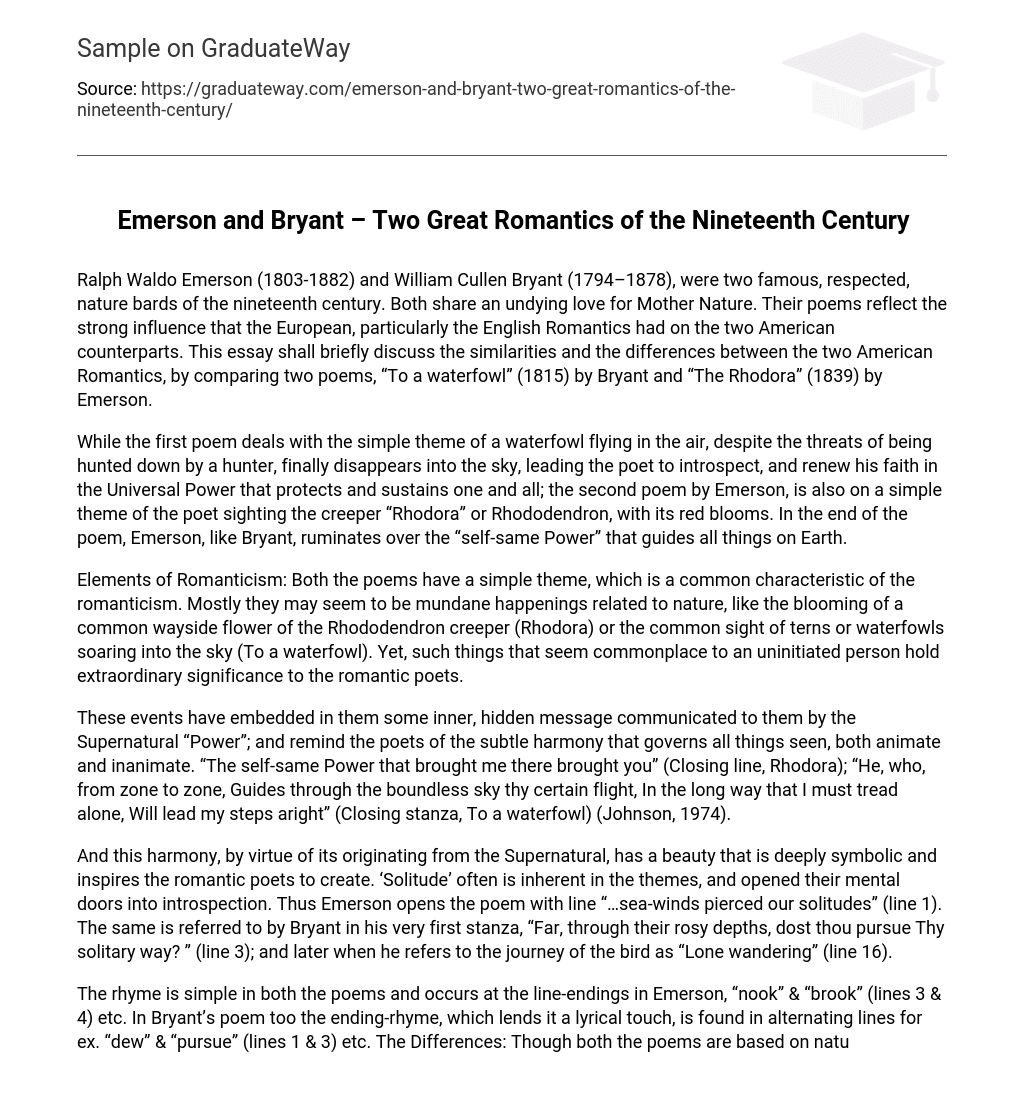Ralph Waldo Emerson (1803-1882) and William Cullen Bryant (1794–1878), were two famous, respected, nature bards of the nineteenth century. Both share an undying love for Mother Nature. Their poems reflect the strong influence that the European, particularly the English Romantics had on the two American counterparts. This essay shall briefly discuss the similarities and the differences between the two American Romantics, by comparing two poems, “To a waterfowl” (1815) by Bryant and “The Rhodora” (1839) by Emerson.
While the first poem deals with the simple theme of a waterfowl flying in the air, despite the threats of being hunted down by a hunter, finally disappears into the sky, leading the poet to introspect, and renew his faith in the Universal Power that protects and sustains one and all; the second poem by Emerson, is also on a simple theme of the poet sighting the creeper “Rhodora” or Rhododendron, with its red blooms. In the end of the poem, Emerson, like Bryant, ruminates over the “self-same Power” that guides all things on Earth.
Elements of Romanticism: Both the poems have a simple theme, which is a common characteristic of the romanticism. Mostly they may seem to be mundane happenings related to nature, like the blooming of a common wayside flower of the Rhododendron creeper (Rhodora) or the common sight of terns or waterfowls soaring into the sky (To a waterfowl). Yet, such things that seem commonplace to an uninitiated person hold extraordinary significance to the romantic poets.
These events have embedded in them some inner, hidden message communicated to them by the Supernatural “Power”; and remind the poets of the subtle harmony that governs all things seen, both animate and inanimate. “The self-same Power that brought me there brought you” (Closing line, Rhodora); “He, who, from zone to zone, Guides through the boundless sky thy certain flight, In the long way that I must tread alone, Will lead my steps aright” (Closing stanza, To a waterfowl) (Johnson, 1974).
And this harmony, by virtue of its originating from the Supernatural, has a beauty that is deeply symbolic and inspires the romantic poets to create. ‘Solitude’ often is inherent in the themes, and opened their mental doors into introspection. Thus Emerson opens the poem with line “…sea-winds pierced our solitudes” (line 1). The same is referred to by Bryant in his very first stanza, “Far, through their rosy depths, dost thou pursue Thy solitary way? ” (line 3); and later when he refers to the journey of the bird as “Lone wandering” (line 16).
The rhyme is simple in both the poems and occurs at the line-endings in Emerson, “nook” & “brook” (lines 3 & 4) etc. In Bryant’s poem too the ending-rhyme, which lends it a lyrical touch, is found in alternating lines for ex. “dew” & “pursue” (lines 1 & 3) etc. The Differences: Though both the poems are based on nature, Emerson’s poem seems to be an obvious celebration of beauty; thus Emerson calls the “Rhodora” a “rival of the rose”, whose “beauty is its own excuse for being” (Emerson, 1839, p 97).
There is no melancholy here. Bryant’s poem is more of a subtle triumph and reflects more of awe and respect, and even melancholy as in “At that far height, the cold thin atmosphere: Yet stoop not, weary, to the welcome land, Though the dark night is near” (lines 18-20). The rhyme scheme is also different in both the poems, with “The Rhodora” having the scheme: aa, bb, cd, cd; ee, ff, gh, gh. “To a waterfowl” is of the rhyme scheme: abab cdcd efef. ghgh…. opop.
Another significant difference is that, though Bryant was a child prodigy, very popular during his times and was very famous for his poems, his works do not exactly find a special place in the history of American romanticism, since his journalistic pursuits left him with little time to produce a wide variety of classical poems which would have stood to his credit (Yarborough, 1994), unlike Emerson, who through his own standing and complete devotion to scholarship, literature and poetic expression, earned himself an indelible place in the history of American Literature.
Bibliography
Bryant, William Cullen, (1815). Web site created and copyrighted by Ann Woodlief <http://www. vcu. edu/engweb/webtexts/Bryant/waterfowl. html> last retrieved on 14th April, 2006. Emerson, Ralph Waldo (1939). The Rhodora. An Anthology American Literature of the Nineteenth Century. Ed. Fisher Samuelson & Reninger Vaid. p 97. New Delhi. Eurasia Publishing House. Curtiss S. Johnson, (1974). Politics and a Belly-full. Westport, Connecticut: Greenwood Press, Publishers. Yarborough, Wynn (1994). William Cullen Bryant. Web site created and copyrighted by Ann Woodlief <http://www. vcu. edu/engweb/webtexts/Bryant/brybio. html> last retrieved on 14th April, 2006.





